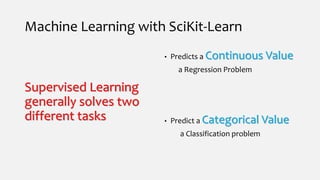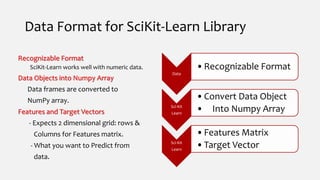MLIntro_ADA.pptx
- 1. Recent Trends • Digital Transformation • COVID-19 Impact • Remote Working • E-Naira based on Blockchains and Cryptocurrencies Technology–Web 3.0 • Low Carbon emission • Natural Language Processing • Driverless Vehicles ~ Elon Musk • Disruptive Tech - Quantum Physics • Fiasco/Disasters/failures - CBN war against AbokiFX Online platform – Sahara Reporters, 19 Sept, 2021. - FG Approves N30bn for roads to Niger Republic – vanguardng, 2 Feb, 2020
- 2. Topic: Exploring the Machine Learning Techniques Name: Emmanuel Ayeni Data Scientist
- 3. Awesome Data Analytics - ADA
- 4. Know What to Learn Data Science Programming (R or Python or SQL) Databases Data Structure & Algorithms Fundamental Math & Stats Data Analysis Data Wrangling Exploration data Analysis & Data Visualization Data Scraping & Data APIs Software Development & Deployment Machine Learning Supervised/Unsupervised
- 5. Data ML Engineer Data Scientist Data Analyst Backend Data Science Frontend Data Science • Advanced Programming
- 6. Targets • Points to Cover • Introduction • The Application of Unsupervised Machine Learning (ML) Models • DEMO: How to Fit a Machine Learning Model to Data sets • Stages & Steps • Results • Evaluation & Conclusions
- 7. Intro: Why? 4th Industrial Revolution • Get ready for the 4th Industrial revolution. • Started from steam and water power. • The computerization • Now represents Combination of Cyber-physical systems, the internet of Things, and the Internet of Systems. • It is an age where machines can visualise a production chain and make decisions on its own The 4 Industrial Revolutions (by Christoph Roser at AllAboutLean.com)
- 8. Intro: Origin - Evolution • Artificial Intelligence (AI) • Machine Learning • Deep Learning https://naolink.com/
- 9. Intro: AI, ML & Deep Learning
- 10. Intro: Focus of Our Learning *** For Every Machine Learning application, the chief question is, “ Which Machine Learning algorithm should we use? “ That's to provide the best prediction data upon a similar new data through a selected.***
- 11. Intro: What is Machine Learning • ML is a field of study that gives computers the ability to learn without being explicitly programmed. (Arthur Samuel) • Traditionally, programmers have to design and code logic programming functions in a clear and detailed manner, leaving no room for confusion or doubts. • ML is an advanced decision-making process - aim is to have a deep understanding of ways of making decisions based strongly on data and information. • Also ML can be considered as an intersection between statistics and computer science.
- 12. Intro: Data Dimensions • Data has now grown to become • Data As A Service • Digital Transformation • New Oil • Data is more like sunshine, abundant and unlimited in its potential ~ Zhiwei Jiang, CEO of Insight & Data GBL • Urbanization • Tech Cities • Key to Sustainable future • Improved Customer Satisfaction
- 13. Machine Learning Data Categories • Numerical Data – The numerical data are numbers and be divided into 2 categories • Discrete Data – Integers e.g. number of cars • Continuous Data – Infinite value, e.g. Price of an item. • Categorical Data – Values that can not be measured up against each other e.g. a colour value, or any yes/no values • Ordinal Data - are like categorical data, but can be measured up against each other, e.g. cardinal points, male/female • NB: It is important to understand data, and data domain synopsis to enable quality in order to derive a good model prediction from your training, and fit to test data prediction.
- 14. Machine Learning Applications ML Applications Manufacturing HealthCare Insurance Customer Service Transportation Commerce Automobile educba
- 15. Overview of fields related to learning from data. AI, artificial intelligence KJIM
- 16. Types of Machine Learning (ML) Supervised ML (SML) • Classification • Regression Unsupervised ML (UML) • Clustering Reinforcement Learning • Control - Respond to Environment
- 17. Overview of Categorical Types and Different Machine Learning KJIM
- 18. Machine Learning Process Diagram Steps involved in data pre-processing : • Importing the required Libraries • Importing the data set • Handling the Missing Data. • Encoding Categorical Data. • Splitting the data set into a test set and training set. • Feature Scaling.
- 19. Advanced Workflow to Develop a Supervised Machine-Learning Based Predictive Model
- 20. Workflow to Develop an Unsupervised Machine-Learning Based Predictive Model
- 21. Supervised Machine Learning (SML) • Feature (X) – What you want to make predications for? • Target (y) – Target (y) – What you want to make predications for?
- 22. Unsupervised Machine Learning (UML) • Feature (X) – What you want to make predications for? • Target (y) – “Missing”?
- 23. Machine Learning Implementation in Python With SCIKIT-LEARN Pkg – Types of ML
- 24. Machine Learning with SciKit-Learn Supervised Learning generally solves two different tasks • Predicts a Continuous Value a Regression Problem • Predict a Categorical Value a Classification problem
- 25. Machine Learning with SciKit-Learn (UML) Unsupervised Learning generally solves Grouping problem • Predicts a Grouping Values Required Functions: • Define Model • Fit Model • Make Predictions • Evaluate
- 26. Data Format for SciKit-Learn Library Recognizable Format SciKit-Learn works well with numeric data. Data Objects into Numpy Array Data frames are converted to NumPy array. Features and Target Vectors - Expects 2 dimensional grid: rows & Columns for Features matrix. - What you want to Predict from data. Data •Recognizable Format Sci-Kit Learn •Convert Data Object • Into Numpy Array Sci-Kit Learn •Features Matrix •Target Vector
- 27. Machine Learning with Sci-Kit Learn Cycle Import SKLearn Libraries Load Data into DF Arrange DF into Features & Target Check and remove or impute missing values Train & Fit Data to Models Model Performance Evaluation SciKit –Learn Models – In general, ML Algorithms are classified into Linear and Non-Linear Algorithms Linear Algorithms: • Linear Regression • Non-Linear Algorithms • Decision Tree Regression/Classification • Random Forest Start
- 28. Machine Learning Stages • Input Data • Machine Learning Algorithm Selection • Predictions • Evaluate • Train ML Algorithm • Model
- 29. Regression Cycle Problem Definition Load Dataset into DF Analyses & Visualise Data Evaluate & standardise with Algorithms Tuning & Ensemble Methods Tune Ensembles & Finalise Method Models – for Regression problems are divided into stages: • Problem Definition • Load Dataset • Analyse Dataset • Visualize Dataset • Evaluate Algorithms • Standardise Dataset • Tuning Methods • Ensemble Methods • Tune Ensemble • Finalise Method
- 30. Conclusion • With ML it is easy to get drowned in the procedures and techniques, however, the message is about data visualisation and in turn predicting target variables no matter the objects that include time units. • Machine learning is at the intersection of computer science and statistics through which computers receive the ability to learn without being explicitly programmed. • There are two broad categories of machine learning problems: supervised and unsupervised learning. • We managed to paint the picture of the reasons and demonstrated UML application of group countries under the correct continents.
- 32. Credits • Michael Galarnyk • Springer • KJIM































